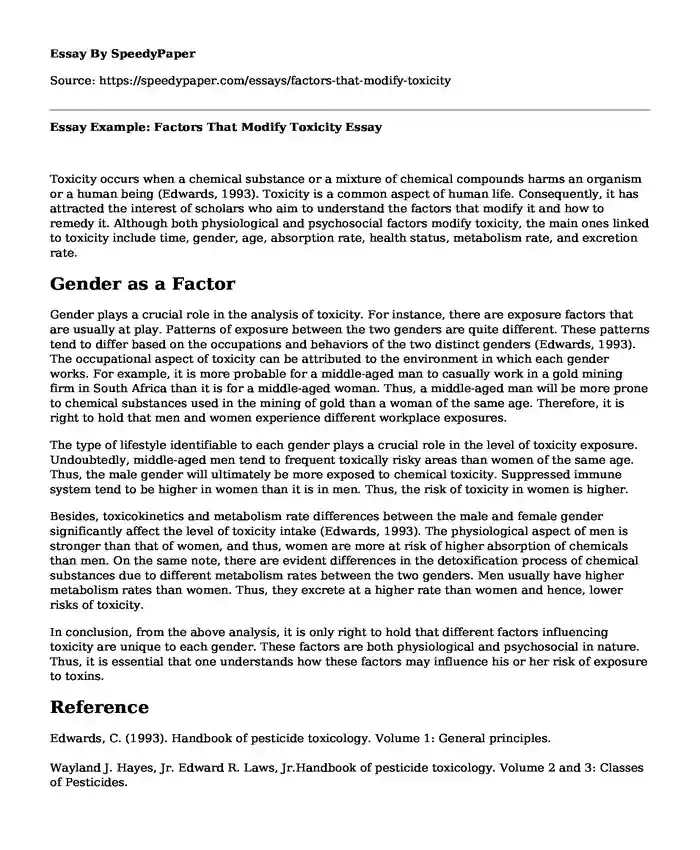
| Type of paper: | Essay |
| Categories: | Gender Chemistry Anatomy Healthcare |
| Pages: | 2 |
| Wordcount: | 469 words |
Toxicity occurs when a chemical substance or a mixture of chemical compounds harms an organism or a human being (Edwards, 1993). Toxicity is a common aspect of human life. Consequently, it has attracted the interest of scholars who aim to understand the factors that modify it and how to remedy it. Although both physiological and psychosocial factors modify toxicity, the main ones linked to toxicity include time, gender, age, absorption rate, health status, metabolism rate, and excretion rate.
Gender as a Factor
Gender plays a crucial role in the analysis of toxicity. For instance, there are exposure factors that are usually at play. Patterns of exposure between the two genders are quite different. These patterns tend to differ based on the occupations and behaviors of the two distinct genders (Edwards, 1993). The occupational aspect of toxicity can be attributed to the environment in which each gender works. For example, it is more probable for a middle-aged man to casually work in a gold mining firm in South Africa than it is for a middle-aged woman. Thus, a middle-aged man will be more prone to chemical substances used in the mining of gold than a woman of the same age. Therefore, it is right to hold that men and women experience different workplace exposures.
The type of lifestyle identifiable to each gender plays a crucial role in the level of toxicity exposure. Undoubtedly, middle-aged men tend to frequent toxically risky areas than women of the same age. Thus, the male gender will ultimately be more exposed to chemical toxicity. Suppressed immune system tend to be higher in women than it is in men. Thus, the risk of toxicity in women is higher.
Besides, toxicokinetics and metabolism rate differences between the male and female gender significantly affect the level of toxicity intake (Edwards, 1993). The physiological aspect of men is stronger than that of women, and thus, women are more at risk of higher absorption of chemicals than men. On the same note, there are evident differences in the detoxification process of chemical substances due to different metabolism rates between the two genders. Men usually have higher metabolism rates than women. Thus, they excrete at a higher rate than women and hence, lower risks of toxicity.
In conclusion, from the above analysis, it is only right to hold that different factors influencing toxicity are unique to each gender. These factors are both physiological and psychosocial in nature. Thus, it is essential that one understands how these factors may influence his or her risk of exposure to toxins.
Reference
Edwards, C. (1993). Handbook of pesticide toxicology. Volume 1: General principles.
Wayland J. Hayes, Jr. Edward R. Laws, Jr.Handbook of pesticide toxicology. Volume 2 and 3: Classes of Pesticides.
Wayland J. Hayes, Jr. Edward R. Laws, Jr. The Quarterly Review of Biology, 68(2), 301-301. https://doi.org/10.1086/418133
Cite this page
Essay Example: Factors That Modify Toxicity. (2023, Aug 22). Retrieved from https://speedypaper.net/essays/factors-that-modify-toxicity
Request Removal
If you are the original author of this essay and no longer wish to have it published on the SpeedyPaper website, please click below to request its removal:
- Free Essay on Asian Pacific Americans
- Essay Sample on Project Management for Constructing a Stadium
- Essay Example Dedicated to the "N" Word
- Essay Example on the Use of Modified Overt Aggression Scale
- Autism: Characteristics, Challenges, & Coping Strategies. Essay Sample
- China's SARS Epidemic: Political, Socioeconomic, & Health Impacts - Essay Sample
- Mental Health and Prisons - Free Essay Example
Popular categories




